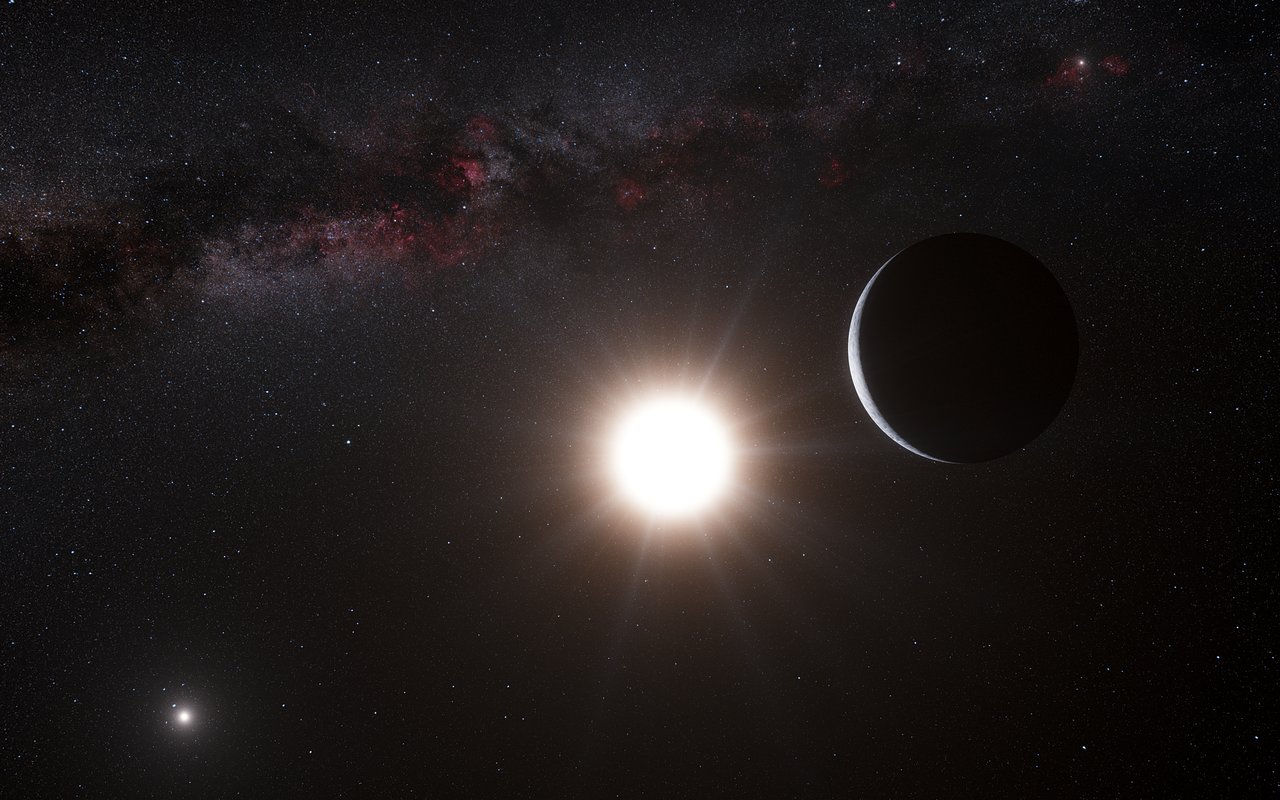|
|
欧洲南天观察台ESO(European Southern Observatory)最近用在智利的直径3.6米的High Accuracy Radial velocity Planet Searcher (HARPS)发现太阳系最近的邻居——比邻星就是半人马座α(Alpha Centauri)有一颗行星。
所谓HARPS就是利用有行星系统的恒星因行星对它的引力拖曳作用,使恒星在空中的轨道在作周期性“抖动”,测量该恒星的在我们和它的视线方向上的抖动速度,计算出行星的方法。很明显,如果恒星的行星的运行轨道平面与我们和恒星间的视线垂直的话,该方法完全无效。
比邻星居太阳系大约是4.3光年。在天文上,这是太阳系的隔壁邻居。这颗(实际是一对恒星,见下)恒星在天空是第三亮的星星。古代中国把它叫做南门二,因为它是在星星天门的南面,把它想像成是大院的南门。
Alpha Centauri 可能是三星系统,Alpha Centauri A和Alpha Centauri B靠得较近,组成一个双星系统。质量非常小的Alpha Centauri C在更远的轨道上0.24光年和A、B星绕共同中心旋转,也有可能它和A、B不是引力绑缚在一起,目前对地点不是很清楚。其中Alpha Centauri A是最亮的星。Alpha Centauri A比太阳略大;而Alpha Centauri B比太阳略小。

这是艺术家的想像图。右上角的小星星是我们的太阳。左小角的是Alpha Centauri A星。
这次发现的行星是围绕Alpha Centauri B 。Alpha Centauri B是和太阳相似的恒星。这颗行星按照目前行星的命名方式被命名为Alpha Centauri Bb。它在离宿主恒星仅6百万公里的轨道上以3.2天的周期旋转。它的质量比地球略大。它的轨道仅有地球居太阳距离的4%(就是它的轨道半径仅有0.04AU),远比太阳系最近的行星水星距太阳的距离五千七百九十万公里的距离要近得多。由于该行星距离宿主恒星太近,尽管恒星的光度仅有太阳的一半,天文学家推测该行星的表面温度可能高达1200摄氏度。那上面不太可能存在液体的水和生命。
欧洲的天文学家声称他们此次用该望远镜达到测量该恒星的径向速度仅有51厘米每秒的数量级。两三年前,这台望远镜的最高灵敏度还是1米每秒。他们已把此类技术达到了目前的极限。他们能测量出如此微小的速度,真是令人惊叹。
他们称此次发现是异乎寻常的。发现这样一颗行星,推测也许还有其他的行星存在,也可能位于“可居住区”内。在理论上讲,一颗恒星仅有一颗行星的情况应是少数,但由于目前测量技术水平的限制,只能发现靠近恒星的,相对质量较大的行星。
由于这个恒星是太阳的近邻,观察起来很方便,未来的岁月里,会有许多望远镜来观察它。
当新一代的望远镜在未来几年内投入使用后,也许会直接观察到它的目前还未知的行星。更有可能会观察到行星是否有大气层。若有的话,其成分是什么。如果它真的在可居住区内有大小合适的行星,那上面有生命存在,将不是什么奇怪的事。
那将是激动人心的时刻。我们期待着。
下面是ESO网站介绍文章的主要部分。
Planet Found in Nearest Star System to Earth European astronomers have discovered a planet with about the mass of the Earth orbiting a star in the Alpha Centauri system — the nearest to Earth. It is also the lightest exoplanet ever discovered around a star like the Sun. The planet was detected using the HARPS instrument on the 3.6-metre telescope at ESO’s La Silla Observatory in Chile. The results will appear online in the journal Nature on 17 October 2012.
Alpha Centauri is one of the brightest stars in the southern skies and is the nearest stellar system to our Solar System — only 4.3 light-years away. It is actually a triple star — a system consisting of two stars similar to the Sun orbiting close to each other, designated Alpha Centauri A and B, and a more distant and faint red component known as Proxima Centauri [1]. Since the nineteenth century astronomers have speculated about planets orbiting these bodies, the closest possible abodes for life beyond the Solar System, but searches of increasing precision had revealed nothing. Until now.
“Our observations extended over more than four years using the HARPS instrument and have revealed a tiny, but real, signal from a planet orbiting Alpha Centauri B every 3.2 days,” says Xavier Dumusque (Geneva Observatory, Switzerland and Centro de Astrofisica da Universidade do Porto, Portugal), lead author of the paper. “It’s an extraordinary discovery and it has pushed our technique to the limit!”
The European team detected the planet by picking up the tiny wobbles in the motion of the star Alpha Centauri B created by the gravitational pull of the orbiting planet [2]. The effect is minute — it causes the star to move back and forth by no more than 51 centimetres per second (1.8 km/hour), about the speed of a baby crawling. This is the highest precision ever achieved using this method.
Alpha Centauri B is very similar to the Sun but slightly smaller and less bright. The newly discovered planet, with a mass of a little more than that of the Earth [3], is orbiting about six million kilometres away from the star, much closer than Mercury is to the Sun in the Solar System. The orbit of the other bright component of the double star, Alpha Centauri A, keeps it hundreds of times further away, but it would still be a very brilliant object in the planet’s skies.
The first exoplanet around a Sun-like star was found by the same team back in 1995 and since then there have been more than 800 confirmed discoveries, but most are much bigger than the Earth, and many are as big as Jupiter [4]. The challenge astronomers now face is to detect and characterise a planet of mass comparable to the Earth that is orbiting in the habitable zone [5] around another star. The first step has now been taken [6].
“This is the first planet with a mass similar to Earth ever found around a star like the Sun. Its orbit is very close to its star and it must be much too hot for life as we know it,” adds Stéphane Udry (Geneva Observatory), a co-author of the paper and member of the team, “but it may well be just one planet in a system of several. Our other HARPS results, and new findings from Kepler, both show clearly that the majority of low-mass planets are found in such systems.”
“This result represents a major step towards the detection of a twin Earth in the immediate vicinity of the Sun. We live in exciting times!” concludes Xavier Dumusque.
ESO will hold an online press conference offering journalists the opportunity to discuss the result and its impact with the scientists. To participate please read our media advisory.
|
|